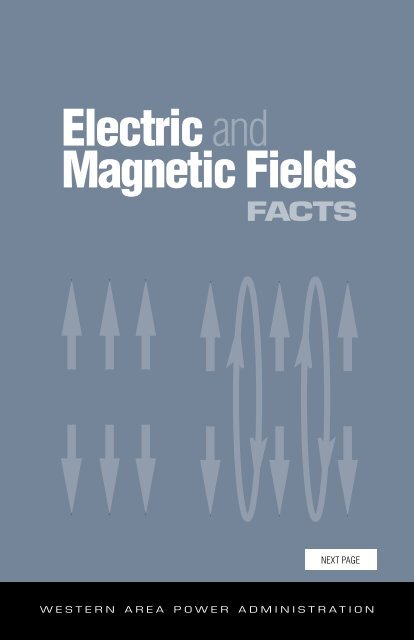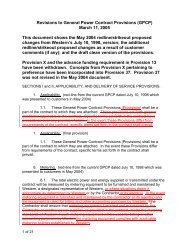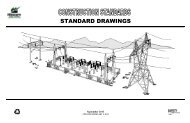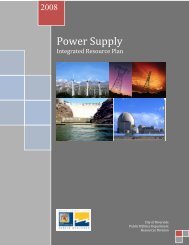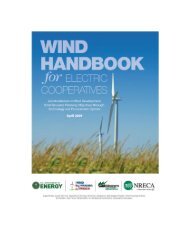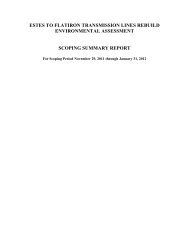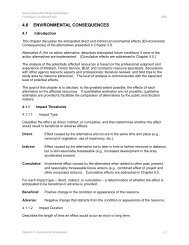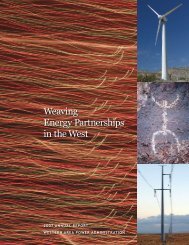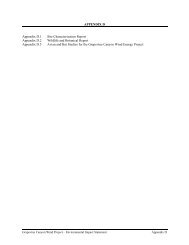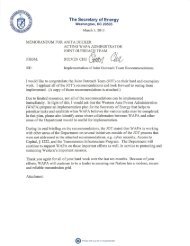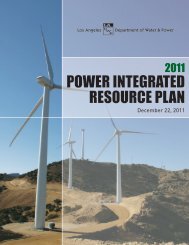Electric and Magnetic Fields Facts - Western Area Power ...
Electric and Magnetic Fields Facts - Western Area Power ...
Electric and Magnetic Fields Facts - Western Area Power ...
Create successful ePaper yourself
Turn your PDF publications into a flip-book with our unique Google optimized e-Paper software.
<strong>Electric</strong> <strong>and</strong><br />
<strong>Magnetic</strong> <strong>Fields</strong><br />
FACTS<br />
NEXT PAGE<br />
W E S T E R N A R E A P O W E R A D M I N I S T R A T I O N<br />
NEXT PAGE PREVIOUS PAGE
EMF Units<br />
<strong>Electric</strong> <strong>Fields</strong><br />
Usually measured in volts per meter (V/m)<br />
For large fields the units usually used are:<br />
1 kilovolt per meter (kV/m) =<br />
1,000 volts per meter<br />
<strong>Magnetic</strong> <strong>Fields</strong><br />
Usually measured in milliGauss (mG)<br />
Other units sometimes used:<br />
1 microTesla = 10 milliGauss<br />
1 Amp/meter = 0.1257 milliGauss<br />
Electromagnetic Spectrum<br />
Gamma<br />
rays<br />
X-rays<br />
Visible<br />
light<br />
60 Hz <strong>and</strong><br />
2,450 MHz<br />
(inside oven)<br />
800-<br />
900 MHz<br />
15-30 kHz<br />
<strong>and</strong> 50-90 Hz<br />
60 Hz<br />
Direct<br />
current<br />
Radiation<br />
Ionizing<br />
10 22<br />
10 20<br />
10 18<br />
10 16<br />
10 14<br />
10 12<br />
10 10<br />
10 8<br />
10 6<br />
10 4<br />
10 2<br />
0<br />
HZ<br />
Frequency is shown in Hertz (Hz). 1 Hz = 1 cycle per<br />
second. (Note that 10 4 means 10x10x10x10 = 10,000<br />
Hz, etc.) kHz = kilohertz = 1000 Hz, MHz = megahertz<br />
= million Hz.<br />
NEXT PAGE<br />
PREVIOUS PAGE
<strong>Electric</strong> power lines are familiar to all of us. They have different<br />
shapes, different sized poles <strong>and</strong> varying numbers of<br />
wires. We may not be able to guess how much power they<br />
carry, but we all know what they do: they bring electric power to<br />
our homes <strong>and</strong> businesses.<br />
Many of the dramatic improvements in health, safety <strong>and</strong><br />
quality of life that we benefit from today could not have happened<br />
without a reliable <strong>and</strong> affordable electric supply. But could<br />
electricity be bad for our health <strong>Electric</strong> <strong>and</strong> magnetic fields are<br />
present wherever electricity is used. Do these fields cause cancer<br />
or any other diseases, as some have suggested<br />
These important <strong>and</strong> serious questions have been investigated<br />
thoroughly during the past three decades. Several tens of millions<br />
of dollars have been spent worldwide.<br />
Research on EMF still continues because no clear answers<br />
have been found. The balance of scientific evidence to date<br />
indicates that these fields do not cause disease. This discussion<br />
outlines the EMF issue, summarizes the research conducted to<br />
date, <strong>and</strong> describes what <strong>Western</strong> <strong>Area</strong> <strong>Power</strong> Administration is<br />
doing to address concerns about EMF.<br />
NEXT PAGE<br />
1<br />
PREVIOUS PAGE
<strong>Electric</strong> <strong>and</strong> <strong>Magnetic</strong> <strong>Fields</strong><br />
EMFs are produced both naturally <strong>and</strong> as a result of human activity. The<br />
earth has both a magnetic field produced by currents deep inside the molten<br />
core of the planet, <strong>and</strong> an electric field produced by electrical activity in the<br />
atmosphere, such as thunderstorms.<br />
A primary characteristic of any field is the frequency. The frequency<br />
describes how rapidly an electric or magnetic field oscillates, or cycles backward<br />
<strong>and</strong> forward every second, <strong>and</strong> is measured in hertz. The earth’s electric<br />
<strong>and</strong> magnetic fields do not oscillate. They are called static fields <strong>and</strong> have a<br />
frequency of 0 Hz. <strong>Electric</strong>ity produced in North America produces fields at<br />
a frequency of 60 Hz, or 60 cycles per second, <strong>and</strong> are known as “extremely<br />
low frequency” or “power frequency” fields. <strong>Fields</strong> at that frequency carry<br />
very little energy <strong>and</strong> are only one small part of the electromagnetic spectrum<br />
that ranges from fields at a frequency of 0 Hz to frequencies in excess<br />
of trillions of Hz. Computers, radios, televisions, cellular telephones, microwave<br />
ovens, X-ray equipment <strong>and</strong> other devices we use daily operate using<br />
Electromagnetic<br />
waveform<br />
Electromagnetic Waveform<br />
1 cycle, 1 wavelength<br />
frequencies within this<br />
spectrum. The science<br />
<strong>and</strong> effects of higher<br />
frequency fields are<br />
quite different from<br />
the 60Hz fields this<br />
brochure focuses on.<br />
<strong>Power</strong> frequency<br />
electric <strong>and</strong> magnetic<br />
fields occur through human<br />
activity wherever<br />
electricity is generated,<br />
transmitted <strong>and</strong> used.<br />
The Difference Between <strong>Electric</strong> <strong>and</strong> <strong>Magnetic</strong> <strong>Fields</strong><br />
<strong>Electric</strong> fields<br />
<strong>Electric</strong> fields are produced by voltage. Voltage is the pressure behind<br />
the flow of electricity. It can be compared to the pressure of water in a hose.<br />
Voltage creates electric fields around any electrical device that is plugged<br />
in—even if it is not operating. For instance, plugging a lamp or hair dryer<br />
NEXT PAGE<br />
2<br />
PREVIOUS PAGE
into a wall socket applies voltage to the cord, surrounding it with an electric<br />
field. <strong>Electric</strong> fields are strongest closest to the source <strong>and</strong> with higher<br />
voltages, but decrease rapidly within a short distance from the source. Walls,<br />
roofs, trees <strong>and</strong> vegetation also weaken or shield electric fields. <strong>Electric</strong> fields<br />
are measured in volts per meter.<br />
<strong>Electric</strong> fields<br />
<strong>Magnetic</strong> <strong>Fields</strong><br />
1. Produced by voltage.<br />
Lamp plugged in but turned off.<br />
Voltage produces an electric field.<br />
2. Measured in volts per meter (V/m) or in<br />
kilovolts per meter (kV/m).<br />
1 kV = 1000V<br />
3. Easily shielded (weakened)<br />
by conducting objects like trees <strong>and</strong><br />
buildings.<br />
4. Reduced in strength with<br />
increasing distance from the source.<br />
1. Produced by current<br />
Lamp plugged in <strong>and</strong> turned on.<br />
Current now produces a magnetic field, also.<br />
2. Measured in gauss (G) or tesla (T)<br />
1 milligauss (mG) = 0.1 microtesla (µT) milli<br />
(m) = 1 thous<strong>and</strong>th<br />
micro (µ) = 1 millionth.<br />
3. Not easily shielded (weakened) by most<br />
materials.<br />
4. Reduced in strength with increasing distance<br />
from the source.<br />
<strong>Magnetic</strong> fields<br />
<strong>Magnetic</strong> fields are produced by current, which is the flow of electricity.<br />
Current is measured in amperes, or amps, <strong>and</strong> is similar to the volume of<br />
water flowing in a hose when the nozzle is open. Current must be flowing<br />
before magnetic fields can be produced. For example, turning on an electric<br />
appliance causes magnetic fields to surround the cord <strong>and</strong> appliance.<br />
<strong>Magnetic</strong> fields are strongest closest to the source, <strong>and</strong> increase with higher<br />
current flow; they also decrease with distance from the source. Unlike electric<br />
fields, magnetic fields are not affected by walls or trees, <strong>and</strong> primarily depend<br />
on distance from <strong>and</strong> strength of the source. <strong>Magnetic</strong> fields are commonly<br />
measured in milliGauss (mG) <strong>and</strong> in microTeslas (µT).<br />
NEXT PAGE<br />
3<br />
PREVIOUS PAGE
Typical 60 Hz magnetic field levels<br />
from some common home appliances<br />
<strong>Magnetic</strong> field 6 Inches<br />
from appliance (mG)<br />
<strong>Magnetic</strong> field<br />
2 feet away (mG)<br />
<strong>Electric</strong> shaver 100 -<br />
Vacuum cleaner 300 10<br />
<strong>Electric</strong> oven 9 -<br />
Dishwasher 20 4<br />
Microwave oven 200 10<br />
Hair dryer 300 -<br />
Computers 14 2<br />
Fluorescent lights 40 2<br />
Faxogram machines 6 -<br />
Copy machines 90 7<br />
Garbage disposals 80 2<br />
Exposure<br />
St<strong>and</strong>ards <strong>and</strong> Guidelines<br />
It is not known if any EMF levels are unsafe. Some nongovernmental<br />
organizations have set advisory limits as a precautionary measure based<br />
on the knowledge that high levels of fields (more than 1,000 times the EMF<br />
found in typical environments) may induce currents in cells or stimulate<br />
nerves. The International Commission on Non-Ionizing Radiation Protection<br />
has established a continuous magnetic field exposure limit of 0.833 Gauss<br />
(833 mG) <strong>and</strong> a continuous electric field exposure limit of 4.2 kV/m for members<br />
of the general public. The American Council of Governmental Industrial<br />
Hygienists publishes Threshold Limit Values for various physical agents. The<br />
TLV for occupational exposure to 60 Hz magnetic fields has been set as 10 G<br />
(10,000 mG) <strong>and</strong> 25 kV/m for electric fields. Several states have set guidelines<br />
for electric <strong>and</strong> magnetic field levels that must be met for newly constructed<br />
transmission lines. These levels at the edge of right-of-way are about 2 kV/m<br />
NEXT PAGE<br />
4<br />
PREVIOUS PAGE
for electric fields <strong>and</strong> 200 mG for magnetic fields. In most cases, the values<br />
are maximum fields that existing lines produce at maximum load-carrying<br />
conditions. Researchers have used 2 mG in several studies as the threshold<br />
magnetic field value to differentiate between average exposed <strong>and</strong> more<br />
exposed persons. This is based on average fields found in homes, <strong>and</strong> not for<br />
any scientific reason.<br />
Natural sources<br />
The earth’s fields are static, or 0 Hz frequency. The earth’s magnetic field<br />
which everyone is constantly exposed to is about 500 mG. The earth’s electric<br />
field is about 100 V/m, but thunderstorms can temporarily increase the field<br />
in a given location to several thous<strong>and</strong> V/m.<br />
Sources within the home<br />
In the home, in addition to the earth’s natural fields, there are power<br />
frequency fields. All electric appliances produce electric <strong>and</strong> magnetic fields<br />
with a 60 Hz frequency. <strong>Fields</strong> are greatest closest to the surface of the cord<br />
<strong>and</strong> appliance <strong>and</strong> drop rapidly in just a short distance. The average household<br />
background 60 Hz magnetic field is about 1 to 2 mG. The average background<br />
60 Hz electric field is 1 to 20 V/m.<br />
6 inches<br />
40mG<br />
2 feet<br />
2mG<br />
Typical field level<br />
NEXT PAGE<br />
5<br />
PREVIOUS PAGE
Overhead lines<br />
All overhead lines produce fields. The fields are usually the highest<br />
directly under the lines <strong>and</strong> fall rapidly with distance to the sides of the line.<br />
Actual field strengths will, of course, vary depending on the height of the<br />
conductors from the point of measurement.<br />
Typical 60 Hz electric <strong>and</strong> magnetic field levels from overhead power lines<br />
Line<br />
voltage<br />
Centerline<br />
Approx.<br />
edge of<br />
right of way<br />
100 feet 200 feet 300 feet<br />
115 kV<br />
<strong>Electric</strong><br />
field kV/m<br />
<strong>Magnetic</strong><br />
field mG<br />
1.0<br />
30<br />
0.5<br />
6.5<br />
0.07<br />
1.7<br />
0.01<br />
0.4<br />
0.003<br />
0.2<br />
230 kV<br />
<strong>Electric</strong><br />
field kV/m<br />
2.0<br />
1.5<br />
0.3<br />
0.05<br />
0.01<br />
<strong>Magnetic</strong><br />
field mG<br />
57.5<br />
19.5<br />
7.1<br />
1.8<br />
0.8<br />
500 kV<br />
<strong>Electric</strong><br />
field kV/m<br />
7.0<br />
3.0<br />
1.0<br />
0.3<br />
0.1<br />
<strong>Magnetic</strong><br />
field mG<br />
86.7<br />
29.4<br />
12.6<br />
3.2<br />
1.4<br />
<strong>Electric</strong> fields from power lines are relatively stable because voltage does not change. <strong>Magnetic</strong> fields fluctuate greatly<br />
as current changes in response to changing load. The magnetic fields above are calculated for 321 power lines for<br />
1990 mean loads.<br />
6<br />
NEXT PAGE<br />
PREVIOUS PAGE
Underground lines<br />
Underground lines can produce higher magnetic fields directly above<br />
them than an overhead line would produce at ground level, because the<br />
buried cable is closer to the ground surface. <strong>Magnetic</strong> fields fall away more<br />
rapidly than from overhead lines because of some shielding from the earth.<br />
There are no external electric fields produced because of the shielding from<br />
the earth. Underground lines are more expensive to install <strong>and</strong> more difficult<br />
<strong>and</strong> expensive to repair than overhead lines. Because of heat generated at<br />
higher voltages, most underground cables are lower voltage distribution lines,<br />
such as those that provide power to residential neighborhoods.<br />
Substations<br />
EMFs are produced within electric substations, but due to the spacing of<br />
electrical equipment measured field strengths are low outside the fence line.<br />
<strong>Fields</strong> close by a substation are mainly produced by the entering power lines.<br />
Other field sources<br />
We are surrounded daily with fields from many other sources having<br />
frequencies different than 60 Hz. These sources include emissions from computers,<br />
radio <strong>and</strong> television towers, cellular telephones, weather <strong>and</strong> air traffic<br />
control radar, military <strong>and</strong> commercial communications systems, household<br />
<strong>and</strong> industrial remote control devices, intrusion detection equipment <strong>and</strong><br />
many others. <strong>Fields</strong> from 60 Hz electrical systems are a very small sliver of<br />
the total natural <strong>and</strong> man-made electromagnetic spectrum environment we<br />
live in.<br />
Stray voltages<br />
Sometimes, cattle <strong>and</strong> dairy farmers express concern about a herd’s behavior,<br />
weight loss or decreased milk production <strong>and</strong> blame EMFs from nearby<br />
transmission or distribution lines. Investigation of the situation normally<br />
shows the cause to be stray voltages. Stray voltages are from deteriorating<br />
wiring, or defective, or improperly wired or grounded, equipment. While<br />
st<strong>and</strong>ing on damp earth or other conductive ground, the animal receives a<br />
small electric shock when contacting parts of milking equipment, electrically<br />
heated or pumped watering facilities or other electric equipment around the<br />
farm. <strong>Electric</strong> companies usually offer stray voltage diagnosis services.<br />
NEXT PAGE<br />
7<br />
PREVIOUS PAGE
Research into Potential Health Effects<br />
With any issue that involves human health, it is important that scientific<br />
research be conducted to find out about possible causes, effects <strong>and</strong> solutions.<br />
Three main types of research are being conducted to determine if EMFs could<br />
be related to disease.<br />
Epidemiology<br />
Epidemiology is the study of patterns of disease in populations. Epidemiology<br />
looks for any statistical link between exposure to EMF <strong>and</strong> disease in<br />
human populations. Concerns about EMFs were first raised in an epidemiological<br />
study when two scientists suggested that levels of fields encountered<br />
in some homes might lead to childhood cancer. Since then, other diseases including<br />
adult cancers, heart disease, Alzheimer’s disease <strong>and</strong> depression have<br />
been examined to determine if there could be a link between them <strong>and</strong> EMFs.<br />
Epidemiology can only look at populations <strong>and</strong> observe statistical associations.<br />
It cannot eliminate the many other possible factors that could<br />
determine the development of diseases <strong>and</strong>, therefore, cannot prove whether<br />
a particular disease is caused by EMFs.<br />
About 20 epidemiological studies have been performed looking at the<br />
possible link between magnetic fields <strong>and</strong> childhood leukemia. Several other<br />
studies have looked at other diseases in relationship to magnetic fields for the<br />
general population <strong>and</strong> in the workplace. Some studies have found a weak<br />
association with magnetic fields, <strong>and</strong> others have not. Where there is association<br />
suggested, it is usually very near the statistical threshold of significance.<br />
When these studies are repeated, the results are generally not reproduced.<br />
Replication of results is a basic test of scientific validity. Research continues<br />
to look at magnetic fields until a more certain conclusion can be reached.<br />
Very little evidence exists to confirm that electric fields have any association<br />
with childhood cancer, <strong>and</strong> some research suggests specifically they<br />
do not.<br />
NEXT PAGE<br />
8<br />
PREVIOUS PAGE
Theoretical<br />
Theoretical research looks for a possible mechanism that can demonstrate<br />
how the fields could react with living systems. A variety of theories have<br />
been put forth over the years but no such mechanism has been found that<br />
would operate at the levels of fields seen around homes or near power lines.<br />
Biological<br />
The test of any proposed theory or proposed health risk is biological<br />
research in the laboratory to observe the effects of EMFs on cells, tissues <strong>and</strong><br />
organisms. Scientists look for effects that can be successfully replicated in<br />
different laboratories for proof that a cause-<strong>and</strong>-effect relationship exists.<br />
Hundreds of EMF-related biological research projects have been conducted.<br />
In 30 years of research, there have been no such reproducible results. The<br />
evidence from the laboratory is that low EMF levels of the kind experienced<br />
by the public do not cause the diseases that have been claimed.<br />
Our use of electricity has increased exponentially over the past 100 years,<br />
likely resulting in greater daily exposures to power frequency EMFs. In general,<br />
it has been found that rates of cancer, considering improved diagnostic<br />
methods, have remained level or decreased somewhat. While many other<br />
variables are unaccounted for, these two observations would suggest that<br />
exposure to normal 60 Hz field levels is not a major human health issue.<br />
NEXT PAGE<br />
9<br />
PREVIOUS PAGE
EMF Research References<br />
Research related to possible adverse health effects of EMFs has been in<br />
progress for more than 30 years. It is not reasonable to list or summarize<br />
the results of past <strong>and</strong> ongoing research in this document because of the<br />
great amount of information. Work conducted by the National Institute of<br />
Environmental Health Sciences/Department of Energy EMF Research <strong>and</strong><br />
Public Information Dissemination Program provides EMF research information<br />
<strong>and</strong> references. The publication <strong>Electric</strong> <strong>and</strong> <strong>Magnetic</strong> <strong>Fields</strong> Associated<br />
with the Use of <strong>Electric</strong> <strong>Power</strong>, Questions <strong>and</strong> Answers prepared under the<br />
NIEHS/DOE EMF RAPID program, specifically Chapter 6, National <strong>and</strong> International<br />
EMF Reviews, <strong>and</strong> Chapter 7, References, supplies a comprehensive<br />
summary <strong>and</strong> listing of research. The document is available online at http:<br />
//www.niehs.nih.gov/emfrapid. Another NIEHS report is Questions <strong>and</strong><br />
Answers, EMF in the Workplace.<br />
Additional EMF information resources are available from:<br />
California Department of Health Services<br />
California EMF Program<br />
http://www.dhs.ca.gov/ps/deodc/ehib/emf/general.html<br />
Medical College of Wisconsin, Electromagnetic <strong>Fields</strong> <strong>and</strong> Human Health<br />
http://www.mcw.edu/gcrc/cop/powerlines-cancer-FAQ/toc.html<br />
Environmental Health Information Service<br />
http://ehis.niehs.nih.gov/<br />
Microwave News<br />
http://www.microwavenews.com<br />
World Health Organization<br />
http://www.who.int/emf<br />
NEXT PAGE<br />
10<br />
PREVIOUS PAGE
Limiting Exposure to EMF<br />
Research has not determined if exposure to EMFs could be a health risk.<br />
Scientists are studying long-term exposure to low fields, exposure to certain<br />
transient waves <strong>and</strong> other kinds of EMFs. You may prefer to take low- <strong>and</strong><br />
no-cost steps to limit your exposure to strong fields as a way to reduce potential<br />
risk. Some scientists call this “prudent avoidance.” For instance, you<br />
might:<br />
■ Move your motor-driven electric clocks or other electrical devices<br />
away from your bed.<br />
■ St<strong>and</strong> away from an operating microwave oven or other appliances<br />
that use a lot of electricity.<br />
■ Sit away from the TV <strong>and</strong> at least an arm’s length away from the computer<br />
screen <strong>and</strong> processing unit.<br />
■ Decide to use a safety razor instead of an electric one.<br />
While steps like these may lower your exposure to 60 Hz fields, it is far<br />
more difficult to limit exposure to EMFs in the rest of the vast electromagnetic<br />
spectrum. It is virtually impossible to reduce exposure to broadcast frequencies<br />
<strong>and</strong> radar, for instance. Some scientists have recommended limiting<br />
cell phone use as a prudent avoidance measure, however.<br />
NEXT PAGE<br />
11<br />
PREVIOUS PAGE
<strong>Western</strong>’s EMF Position<br />
<strong>Western</strong> recognizes the public concern over the possible health effects of<br />
electric <strong>and</strong> magnetic fields. While primary exposure to EMFs for most people<br />
is in the home <strong>and</strong> at work, <strong>Western</strong> realizes that some people have concerns<br />
about EMFs created by our transmission facilities.<br />
In the past 30 years, scientists have studied the relationship, if any, of<br />
EMF to human, plant <strong>and</strong> animal health. Congress m<strong>and</strong>ated in 1992 that<br />
Federal agencies <strong>and</strong> the scientific community research <strong>and</strong> conduct a comprehensive<br />
review of potential EMF effects on health. These studies concluded<br />
in 1997 that there is only “weak” evidence that magnetic fields increase the<br />
risk of cancer <strong>and</strong> other human disease.<br />
Scientific research continues on a wide range of questions relating to<br />
EMF exposure, <strong>and</strong> some of this work has hinted at possible health risks.<br />
A comprehensive EMF health risk assessment by the World Health Organization<br />
is under way, <strong>and</strong> will likely influence decision making <strong>and</strong> further<br />
research. The research is expected to continue for several more years. Until<br />
conclusive or more specific research results are obtained, <strong>Western</strong> will continue<br />
to take prudent actions regarding EMFs.<br />
<strong>Western</strong> will continue to:<br />
■ Provide balanced <strong>and</strong> accurate information to employees, customers<br />
<strong>and</strong> the public. EMF measurements will continue to be made upon<br />
request.<br />
■ Support <strong>and</strong> participate in scientific research on EMF <strong>and</strong> monitor<br />
results of research activities by utility, government <strong>and</strong> private groups.<br />
■ Pursue <strong>and</strong> implement alternative design <strong>and</strong> siting approaches for<br />
new <strong>and</strong> upgraded transmission facilities to reduce the public exposure<br />
to EMFs, particularly when the siting of the facilities may occur in<br />
populated areas.<br />
<strong>Western</strong> is committed to providing a safe, healthy environment for our<br />
employees <strong>and</strong> safe, reliable <strong>and</strong> economic electric energy to our customer<br />
<strong>and</strong> communities.<br />
NEXT PAGE<br />
12<br />
PREVIOUS PAGE
For more information about <strong>Western</strong> or EMF, call or write your nearest<br />
<strong>Western</strong> office:<br />
Corporate Services Office<br />
Mailing address: P.O. Box 281213, Lakewood, CO 80228-8213<br />
E-mail: CorpComm@wapa.gov<br />
Phone: 720-962-7000<br />
Fax: 720-962-7200<br />
CRSP Management Center<br />
Mailing address: P.O. Box 11606, Salt Lake City, UT 84147-0606<br />
Phone: 801-524-5493<br />
Fax: 970-240-6295<br />
Desert Southwest Region<br />
Mailing address: P.O. Box 6457, Phoenix, AZ 85005-6457<br />
Phone: 602-605-2525<br />
Fax: 602-605-2630<br />
Rocky Mountain Region<br />
Mailing address: P.O. Box 3700, Lovel<strong>and</strong>, CO 80539-3003<br />
Phone: 970-461-7200<br />
Fax: 970-461-7213<br />
Sierra Nevada Region<br />
Mailing address: 114 Parkshore Drive, Folsom, CA 95630-4710<br />
Phone: 916-353-4416<br />
Fax: 916-985-1934<br />
Upper Great Plains Region<br />
Mailing address: P.O. Box 35800, Billings, MT 59107-5800<br />
Phone: 406-247-7405<br />
Fax: 406-247-7408<br />
NEXT PAGE<br />
PREVIOUS PAGE
U<br />
P.O. Box 281213<br />
Lakewood, CO 80228-8213<br />
8-05<br />
N ITED STAT<br />
E<br />
S OF A<br />
MERICA<br />
DEPARTMEN<br />
T OF ENERGY<br />
PREVIOUS PAGE


